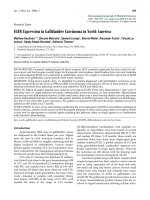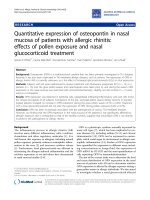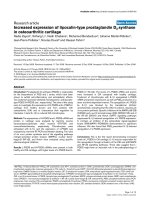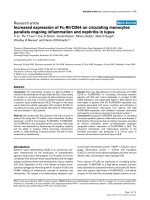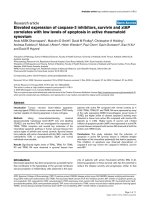Báo cáo y học: " EGFR Expression in Gallbladder Carcinoma in North America" doc
Bạn đang xem bản rút gọn của tài liệu. Xem và tải ngay bản đầy đủ của tài liệu tại đây (665.72 KB, 7 trang )
Int. J. Med. Sci. 2008, 5
285
International Journal of Medical Sciences
ISSN 1449-1907 www.medsci.org 2008 5(5):285-291
© Ivyspring International Publisher. All rights reserved
Research Paper
EGFR Expression in Gallbladder Carcinoma in North America
Matthew Kaufman
1
, Bhoomi Mehrotra
1
, Sewanti Limaye
1
, Sherrie White
2
, Alexander Fuchs
1
, Yehuda Le-
bowicz
1
, Sandy Nissel-Horowitz
1
, Adrienne Thomas
1
1. Long Island Jewish Medical Center, New Hyde Park, NY 11040, USA
2. Hartford Hospital, Hartford, CT, USA
Correspondence to: Long Island Jewish Medical Center, Division of Hematology/Oncology, 270-05 76
th
Avenue, New Hyde Park, NY
11040. Telephone 718-470-8934; Facsimile 718-470-0169; Email:
Received: 2008.02.18; Accepted: 2008.09.19; Published: 2008.09.22
BACKGROUND: Increased epidermal growth factor receptor (EGF receptor) expression has been noted in vari-
ous cancers and has become a useful target for therapeutic interventions. Small studies from Asia and Australia
have demonstrated EGFR over-expression in gallbladder cancer. We sought to evaluate the expression of EGFR
in a series of 16 gallbladder cancer patients from North America.
METHODS: Using tumor registry data, we identified 16 patients diagnosed with gall bladder carcinoma at our
medical center between the years of 1998 and 2005. We performed a retrospective review of these patients’ charts,
obtained cell blocks from pathology archives and stained for EGFR and Her2/neu.
RESULTS: Fifteen of sixteen patients were noted to over-express EGFR. Three were determined 1+, nine were 2+
and three were 3+. Eight patients had poorly differentiated adenocarcinoma, six had moderately differentiated
and two had well-differentiated tumors. In this small series, there was a trend toward shorter survival and more
poorly differentiated tumors in patients with greater intensity of EGFR expression. One patient was EGFR nega-
tive but 3+ for erb-2/Her 2-neu expression. No patient co-expressed EGFR and Her-2-neu. Median survival of
patients in this series was 17 months.
CONCLUSION: In view of our observations confirming the over-expression of EGFR in our patient population in
North America, and the recent success of EGFR targeted therapies in other solid tumors that over-express EGFR,
it may now be appropriate to evaluate agents targeting this pathway either as single agents or in combination
with standard chemotherapy.
Key words: gallbladder cancer, endothelial growth factor receptor (EGFR), differentiation, survival, her-2-neu
Introduction
Approximately 5000 cases of gallbladder cancer
are diagnosed in the United States per year. Higher
rates are seen in Latin American countries such as
Mexico, Chile and Bolivia, roughly correlating with the
higher incidence of cholelithiasis. Various chemo-
therapy agents, including 5-FU and Gemcitabine, have
been evaluated for the management advanced disease
but thus far results have been disappointing [1-4].
5 FU plus LV has been the backbone of random-
ized clinical trials done in the past, demonstrating a RR
of 32% and OS of 6months.[5] Combination therapy
with 5FU and cisplatin have shown RRs of 10%–40%
and median OS better than those observed with 5-FU
alone.[5-12] Single agent gemcitabine has been exten-
sively evaluated in patients with metastatic biliary
tract tumors with RRs in the range of 0%–30%, with
median OS times in the range of 5–14 months.
[13-18]Gemcitabine combinations with cisplatin, ox-
aliplatin or capecitabine have been tested in several
clinical trials, which have demonstrated RRs 21%–53%
and median OS times 5–15 months; these results are
somewhat better than those from single-agent gem-
citabine studies.[19-23] A pooled analysis of 112 trial
using gemcitabine-based combination regimens con-
firmed superiority to single agent therapy. However
the outcomes are still dismal with the pressing need
for development of newer therapies.[1, 24, 25]
Increased epidermal growth factor receptor (EGF
receptor) expression has been noted in various cancers
such as colon, squamous cell of the head and neck,
non-small cell lung and breast cancers. Several small
studies from Asia, Europe and Australia have exam-
ined the expression of EGFR in gallbladder can-
cer.[26-30] The epidermal growth factor receptor is one
of many transmembrane protein kinases that are in-
volved in signal transduction affecting cellular activi-
Int. J. Med. Sci. 2008, 5
286
ties such as metabolism, transcription, cell-cycle pro-
gression, apoptosis and differentiation.[31] These
processes are tightly controlled, but when protein
kinase activity is deregulated, malignant transforma-
tion may occur. [32] Among the various mechanisms
of increased EGFR activation, is receptor
over-expression, gene amplification and the loss of
inhibitory signals. Activation of EGFR results in
phosphorylation of intracellular substrates down-
stream and the subsequent activation of mitotic path-
ways. [32]
The improved understanding of EGFR’s role in
oncogenesis has made it an attractive target for thera-
peutic intervention in several cancers. Clinical and
preclinical data exist utilizing this target in colon can-
cer, squamous cell carcinoma of the head and neck,
non-small cell lung cancer and breast cancer. [33-41]
Likewise, the over-expression of EGFR on gallbladder
carcinoma may have direct clinical implications with
an alternative management strategy for the manage-
ment of this difficult disease. [42, 43] In our study, we
have gathered the data showing over-expression of
EGFR in gallbladder cancer cases in North America.
Materials and Methods
Data Retrieval
Institutional Review Board approval was ob-
tained. Tumor registry data identified patients diag-
nosed with gall bladder carcinoma at a single institu-
tion between the years of 1998 and 2005. We per-
formed a retrospective review of these consecutive
patients’ charts and obtained the following informa-
tion: biopsy site, stage at diagnosis, treatment modali-
ties, survival, and tumor grade. Cell blocks were then
obtained from pathology archives and stained for
EGFR and Her2/neu as described below.
Methods for EGFR and Her 2/neu staining
Serial 4µm sections were cut from the cell block.
Slides were then placed in xylene for 15 minutes for
deparaffinization. Dehydration was performed by
steps of graded alcohol. Tap water was used for rehy-
dration. Slides stained with Her-2/neu (prediluted,
monoclonal, clone CB11, Carpinteria, CA) were then
pretreated for antigen retrieval by microwaving for 30
minutes using citrate buffer, pH 6. They were then
stained using the Ventana Nexus autostainer. Slides
stained with EGFR (prediluted, monoclonal, clone
2-18C9, Carpinteria, CA) were not pretreated for anti-
gen retrieval and were stained using the Ventana
autostainer.
Two observers who were blinded to the histologic
diagnosis interpreted the slides. Cell membrane stain-
ing was used to assess positivity for EGFR and Her
2/neu. In each case, the intensity of the staining (0-
negative to 3- strong) was determined. (Figure 1a-c).
Figure 1. EGFR Staining.
Int. J. Med. Sci. 2008, 5
287
The staining pattern for Her2-neu was deter-
mined as follows: Score 0= no staining is observed;
Score 1+= faint membrane staining in more than 10%
of tumor cells in part of the cell membrane; score 2+=
weak to moderate complete membrane staining in
over 10% of tumor cells; score 3+= strong complete
membrane staining in over 10% of tumor cells.
The staining pattern for EGFR was determined as
follows: Score 0= no staining is observed; Score 1+=
faint membrane staining in more than 1% of tumor
cells in part of the cell membrane; score 2+= weak to
moderate complete membrane staining in over 1% of
tumor cells; Score 3+=strong complete membrane
staining in over 1% of tumor cells.
Results
In our series of sixteen patients, fifteen were
noted to over-express EGFR (Table 1). Three were de-
termined 1+, nine were 2+ and three were 3+. Eight
patients had poorly differentiated adenocarcinoma, six
had moderately differentiated and two had
well-differentiated tumors. One patient was EGFR
negative but 3+ for erb-2/Her 2-neu expression. Nine
of 16 patients underwent surgical intervention alone,
three underwent chemotherapy alone, two underwent
both surgery and chemotherapy and two underwent
surgery, chemotherapy and radiation therapy. Staging
distribution was as follows: stage I: 12.5%(n=2); stage
II: 37.5%(n=6); stage III: 12.5% (n=2); stage IV:
37.5%(n=6).
Table 1. Results
Patient Age Sex Stage Biopsy Site Rx modality Survival differentiation/Grad Erb-B-2/Her 2-neu EGFR
1 83 M II gallbladder S 40 months poor diff adenocarcinom 3+ negative
2 76 F II gallbladder S 12 months mod diff adenocarcinom negative 1+
3 61 F IV gallbladder S 17 months well-diff adenocarcinom negative 1+
4 62 F IV peritoneum C 9 months mod diff adenocarcinom negative 1+
5 54 F IV liver C 10.5 months mod diff adenocarcinom negative 2+
6 77 F I gallbladder S 28 months (alive) poor diff adenocarcinom negative 2+
7 65 F II gallbladder S 11 months mod diff adenocarcinom negative 2+
8 70 F II gallbladder S,C,R 25 months (alive) well-diff mucinous adenocarc negative 2+
9 55 F IV omentum C 4 months poor diff adenocarcinom negative 2+
10 63 M II gallbladder S 33 months(alive) mod diff adenocarcinom negative 2+
11 71 F III gallbladder S 50 months (alive) poor diff adenocarcinom negative 2+
12 68 F II gallbladder S,R,C 19 months poor diff adenocarcinom negative 2+
13 75 F IV peritoneum S,C 27 months mod diff adenocarcinom negative 2+
14 80 F I gallbladder S 17 months poor diff adenocarcinom negative 3+
15 74 F IV gallbladder S,C 3.5 months poor diff adenocarcinom negative 3+
16 46 F III gallbladder S 2.5 months poor diff adenocarcinom negative 3+
S=surgery, C=chemotherapy, R=radiation
We evaluated a possible correlation between the
level of differentiation and intensity of EGFR expres-
sion. The three patients with 1+ expression had
well-differentiated (one patient) and moderately dif-
ferentiated (two patients) adenocarcinoma. Con-
versely, all three of the 3+ EGFR patients had tumors
of the poorly differentiated type. The nine patients
with 2+ EGFR was a mix of the former groups (one
well-differentiated, four moderately differentiated and
four poorly differentiated). This suggests an inverse
relationship between differentiation and EGFR ex-
pression. Median survival of the 3+ patients was 3.5
months compared to 17 months overall.
Although our sample size is small, our data above
also suggests an inverse relationship between EGFR
expression intensity and survival. The patient with
stage I disease with 3+ EGFR staining had a survival of
17 months versus the other stage I patient in our sam-
ple, who had 2+ EGFR staining, and is alive at 28
months follow-up. The patient with stage IV disease
expressing 3+EGFR, had a survival of 3.5 months
compared to the median survival of 10.5 months for
stage IV patients with 1+ and 2+ staining. In summary,
the 3+ patients had a substantially shorter survival
when compared with less intense EGFR expression
patients of similar stage.
Int. J. Med. Sci. 2008, 5
288
Discussion
Background of EGFR
Epidermal growth factor receptor is a protein
kinase receptor involved in the signal transduction
affecting cellular activities such as metabolism, tran-
scription, cell-cycle progression, apoptosis and differ-
entiation. The two major subsets of drugs that inhibit
EGF receptors are monoclonal antibodies and small
molecules. The monoclonal antibodies prevent ligand
binding and activation of the EGFR. One agent of this
type is cetuximab, which has shown clinical efficacy in
colon, [31, 32] and head and neck cancers. [31] Small
molecules that target EGFR compete with ATP binding
to the tyrosine kinase domain, thereby blocking sig-
naling pathways.[32] Examples of drugs of this type
are gefitinib and erlotinib. Erlotinib has shown activity
against non-small cell lung and pancreatic cancers.
EGFR Expression in our sample of Gallbladder cancer
patients
As with the available published data from Asia
and Australia, we found a predominance of EGFR
over-expression in our gallbladder cancer specimens.
In our sample of 16 patients, only one patient (6.3%)
did not have over-expression of EGFR. Nine pa-
tients(56.3%) were 2+ and three(18.3%) were 3+ in
immunohistochemical staining. All fifteen of the pa-
tients expressing EGFR were negative for Erb-B-2/Her
2-neu. Conversely, the single patient that expressed
Erb-B-2/Her 2-neu was 3+ intensity, and was negative
for EGFR. We found it interesting that these two re-
ceptors, both of the erb-B family, have no
co-expression in any of our patients.
As shown in the results, a disproportionate
number of patients with 3+ EGFR expression had
poorly differentiated tumors. Conversely, the patients
with 1+ EGFR expression seemed to have proportion-
ally higher numbers of patients with moderate or
well-differentiated tumors. This suggests an inverse
relationship between differentiation and EGFR ex-
pression. Assuming that poorly differentiated tumors
behave more aggressively, intensity of EGFR expres-
sion may correlate with aggressiveness of disease.
This hypothesis is further supported by the ex-
amining the EGFR expression relating to survival.
Stage for stage, the patients with greater EGFR inten-
sity had shorter survival therefore suggesting an in-
verse relationship between EGFR expression intensity
and survival. Although the number of patients is few,
this is a consistent pattern throughout our sample. The
patient with stage I disease with 3+ EGFR staining had
a survival of 17 months versus the other stage I patient
in our sample, who had 2+ EGFR staining, and is alive
at 28 months follow-up. The patient with stage IV
disease expressing 3+EGFR, had a survival of 3.5
months compared to the median survival of 10.5
months for stage IV patients with 1+ and 2+ staining.
In summary, the 3+ patients had a substantially shorter
survival when compared with less intense EGFR ex-
pression patients of similar stage.
Previous studies of EGFR Expression in Biliary Tu-
mors
A study from MD Anderson demonstrated that
constitutive expression of ErbB-2 in mice resulted in
development of gallbladder cancer. [44]Several small
studies, mostly from Asia, have complemented this
work by examining the level of expression of EGFR in
biliary tumors (Table 2). These few studies demon-
strated a significant and consistent over-expression of
epithelial growth factor receptor in biliary tumors. The
largest such study was published by Zhou et al from
China.[26] Zhou compared EGFR expression in normal
gallbladder specimens (10 specimen) with gallbladder
carcinoma specimen (41 specimens) and hyperplastic
tissue specimens (26) using immunohistochemistry.
EGFR over-expression was found to be 71% in the car-
cinoma specimens as compared to 0% of the normal
gallbladder specimens. Lee et al performed immuno-
histochemistry stains for EGFR on 13 gallbladder can-
cer specimens from Australia.[29] 100% of the gall-
bladder cancer specimens were found to stain strongly
positive for EGFR.
Table 2. EGFR expression in Biliary Tumors.
Study N Immunoreactivity(%)
Lee et al.[29] Gallbladder-13
Biliary duct-7
100%
86%
Kim et al.[52] Biliary duct-20 25%
Zhou et al.[26] Gallbladder-41 71%
Table 3. Single agent Gemcitabine.
Study N Response
Rate (%)
Stable
Disease
Time to
Progres-
sion
(months)
Median
Overall
Survival
Eng et al.[53] 14 0% 13% 9 months 5 months
Mehrotra et al[54] 12 0% 75% 3 months 6 months
Funakoshi et al.[55] 40 17.5% 2.6
months
7.6 months
Tsavaris et al [56] 30 30% 7 months 17 months
(Gallblad-
der)
11 months
(biliary
duct)
Gallardo et al.[57] 26 36% 36.7%
Park et al.[58] 23 26% 39% 8.1
months
13.1 months
Kubicka et al.[17] 23 30%
Int. J. Med. Sci. 2008, 5
289
Table 4. Gemcitabine Combinations.
Study Treatment N Response
Rate (%)
Median
Time to
Progression
Median
Overall
Survival
Doval et al
[59]
Gemcitabine
+ cisplatin
39 37% 4.5 months 5 months
Park et
al.[58]
Gemcitabine
+ cisplatin
35 17% 3.5 months 8.3
months
Malik et
al.[60]
Gemcitabine
+ cisplatin
11 64% 6.5 months 10
months
Reyes-Vidal
et al [61]
Gemcitabine
+ cisplatin
44 48% 7 months
Tan et al.[22] Gemcitabine
+ carboplatin
13 31%
Knox et
al.[3]
Gemcitabine
+ Capecit-
abine
45 31% 7 months 14
months
Chang et al
[23]
Gemcitabine
+ Capecit-
abine
34 12% 2.6 months 7.8
months
Verderame
et al [24]
Gem
citabine
+
Oxaliplatin
24 50% 12
months
Wagner et al
[25]
Gem
citabine
+ Oxaliplatin
+
CI 5-FU
35 9.9
months
NCCTG [26] Gemcitabine
+
CI 5-FU/LV
42 9.5% 4.6 months 9.7
months
Knox [27] Gemcitabine
+
CI 5-FU/LV
27 33% 3.7 months 5.3
months
Knox et
al.[3]
Gemcitabine
+ Capecit-
abine
45 31% 7 months 14
months
Table 5. Non-Gemcitabine Regimens.
Study Treatment N Response Rate
(%)
Romano et al[62]
Cisplatin + iri-
notecan
16 37%
Nehls et al.[63] Capecitabine +
Oxaliplatin
27 27%
Glover et al.[64] Capecitabine +
Oxaliplatin
21 19%
Sanz-Altamira[65] Carboplatin +
5-FU/LV
14 21%
Current studies in EGFR related therapy of Gallblad-
der Cancer
Several trials have been undertaken in the past
investigating chemotherapy for advanced biliary can-
cers, including cancer of the gallbladder. Many of these
trials involved gemcitabine, either as a single agent
(table 3) or in combination with other chemotherapies
(table 4).[1, 2] Other trials have looked at non gemcit-
abine based combination therapies (table 5). The re-
sponse rates have been between 21%–53% and median
OS times 5–15 months.[1] With limited improvement
in responses and survival with the combination
chemotherapies, the focus is now on evolution of
newer targeted therapies.
Several studies targeting the EGFR pathway have
been undertaken. In a phase II study of 42 patients
with biliary tract cancer treated with single-agent er-
lotinib, Philip et al. demonstrated a 17% 6-month pro-
gression-free survival (PFS) rate; three patients had
partial responses (PRs) as determined by the Response
Evaluation Criteria in Solid Tumors. Of these patients,
57% had received first line chemotherapy. [45] In this
study, EGFR mutation status was not tested, and
therefore it is unknown if the response correlated with
EGFR mutation status. There is a possibility that the
population of patients with the EGFR mutation might
have a significant benefit from EGFR inhibition ther-
apy, along the lines of non-small cell lung cancer pa-
tients. [2, 46]
Efficacy of cetuximab, in biliary tract and gall-
bladder cancers, in combination with either Gemcit-
abine or gemcitabine and oxaliplatin have been dem-
onstrated in two studies [42, 43]. Lapatinib, a dual
EGFR-1and humanepidermal growth factor receptor
(HER)-2/Neu inhibitor, was tested in a phase I trial in
seven patients with biliary tract cancer. [47]
In a recently completed phase II study, patients
with locally advanced/metastatic cholangiocarcinoma
or gallbladder cancer were given cetuximab 500
mg/m² on day 1 followed by 1,000mg/m² gemcitabine
(day 1) and 100mg/m² oxaliplatin on day 2 every sec-
ond week. The primary endpoint was response rate;
secondary endpoints were toxicity, progression free
and overall survival. The overall response rate of 19
evaluable patients was 58%, including one patient with
a complete response. Six patients (32%) achieved stable
disease and 2 patients (11%) progressed under che-
motherapy after a median of 6.5 cycles (SD ± 2.8). The
response significantly correlated with the grade of
acne-like rash (p < 0.002). Six initially unresectable
patients underwent a curative resection after major
response was observed (32%). The median PFS was 9.0
months (95% CI 3.1-14.9). Four patients are currently
without evidence of disease after a median follow-up
of 6.3 months post-liver resection[42]. Bevacizumab
and sorafenib are also under investigation for treat-
ment of both these cancers.[48] [49]
The finding of over-expression of EGFR in our
patient population in North America further
strengthens the rationale in targeting this pathway in
gallbladder cancer [35, 38, 40, 41]. Additional clinical
trials are underway exploring the role of EGFR inhibi-
tion in this malignancy. Decreased response to EGFR
inhibitors has been reported in Kras mutant patients in
colorectal cancer[39-41]. In this context, Kras mutation
status in patients with biliary tract and gallbladder
warrants further investigation as use of EGFR inhibi-
tors grows. [50, 51]
Int. J. Med. Sci. 2008, 5
290
Conflict of Interest
The authors have declared that no conflict of in-
terest exists.
References
1. Eckel F and Schmid RM. Chemotherapy in advanced biliary tract
carcinoma: a pooled analysis of clinical trials. Br J Cancer, 2007.
96(6): 896-902.
2. Hezel A.F and Zhu AX. Systemic therapy for biliary tract can-
cers. Oncologist, 2008. 13(4): 415-23.
3. Iyer R.V, et al. A phase II study of gemcitabine and capecitabine
in advanced cholangiocarcinoma and carcinoma of the gall-
bladder: a single-institution prospective study. Ann Surg Oncol,
2007. 14(11): 3202-9.
4. Riechelmann R.P, et al. Expanded phase II trial of gemcitabine
and capecitabine for advanced biliary cancer. Cancer, 2007.
110(6): 1307-12.
5. Choi C.W, et al. Effects of 5-fluorouracil and leucovorin in the
treatment of pancreatic-biliary tract adenocarcinomas. Am J Clin
Oncol, 2000. 23(4): 425-8.
6. Ducreux M, et al. Effective treatment of advanced biliary tract
carcinoma using 5-fluorouracil continuous infusion with cis-
platin. Ann Oncol, 1998. 9(6): 653-6.
7. Ellis P.A, et al. Epirubicin, cisplatin and infusional 5-fluorouracil
(5-FU) (ECF) in hepatobiliary tumours. Eur J Cancer, 1995.
31A(10): 1594-8.
8. Lee M.A, et al. Epirubicin, cisplatin, and protracted infusion of
5-FU (ECF) in advanced intrahepatic cholangiocarcinoma. J
Cancer Res Clin Oncol, 2004. 130(6): 346-50.
9. Mitry E, et al. Combination of folinic acid, 5-fluorouracil bolus
and infusion, and cisplatin (LV5FU2-P regimen) in patients with
advanced gastric or gastroesophageal junction carcinoma. Ann
Oncol, 2004. 15(5): 765-9.
10. Glimelius B, et al. Chemotherapy improves survival and quality
of life in advanced pancreatic and biliary cancer. Ann Oncol,
1996. 7(6): 593-600.
11. Takada T, et al. Comparison of 5-fluorouracil, doxorubicin and
mitomycin C with 5-fluorouracil alone in the treatment of pan-
creatic-biliary carcinomas. Oncology, 1994. 51(5): 396-400.
12. Feisthammel J, et al. Irinotecan with 5-FU/FA in advanced bil-
iary tract adenocarcinomas: a multicenter phase II trial. Am J
Clin Oncol, 2007. 30(3): 319-24.
13. Burris H.A3rd, et al. Improvements in survival and clinical
benefit with gemcitabine as first-line therapy for patients with
advanced pancreas cancer: a randomized trial. J Clin Oncol,
1997. 15(6): 2403-13.
14. Oettle H, et al. Adjuvant chemotherapy with gemcitabine vs
observation in patients undergoing curative-intent resection of
pancreatic cancer: a randomized controlled trial. Jama, 2007.
297(3): 267-77.
15. Raderer M, et al. Two consecutive phase II studies of
5-fluorouracil/leucovorin/mitomycin C and of gemcitabine in
patients with advanced biliary cancer. Oncology, 1999. 56(3):
177-80.
16. Gebbia V, et al. Treatment of inoperable and/or metastatic bil-
iary tree carcinomas with single-agent gemcitabine or in com-
bination with levofolinic acid and infusional fluorouracil: results
of a multicenter phase II study. J Clin Oncol, 2001. 19(20):
4089-91.
17. Kubicka S, et al. Phase II study of systemic gemcitabine chemo-
therapy for advanced unresectable hepatobiliary carcinomas.
Hepatogastroenterology, 2001. 48(39): 783-9.
18. Penz M, et al. Phase II trial of two-weekly gemcitabine in pa-
tients with advanced biliary tract cancer. Ann Oncol, 2001. 12(2):
183-6.
19. Meyerhardt J.A, et al. Phase-II study of gemcitabine and cis-
platin in patients with metastatic biliary and gallbladder cancer.
Dig Dis Sci, 2008. 53(2): 564-70.
20. Lee G.W, et al. Combination chemotherapy with gemcitabine
and cisplatin as first-line treatment for immunohistochemically
proven cholangiocarcinoma. Am J Clin Oncol, 2006. 29(2):
127-31.
21. Kim S.T, et al. A Phase II study of gemcitabine and cisplatin in
advanced biliary tract cancer. Cancer, 2006. 106(6): 1339-46.
22. Andre T, et al. Gemcitabine combined with oxaliplatin
(GEMOX) in advanced biliary tract adenocarcinoma: a GERCOR
study. Ann Oncol, 2004. 15(9): 1339-43.
23. Harder J, et al. Outpatient chemotherapy with gemcitabine and
oxaliplatin in patients with biliary tract cancer. Br J Cancer, 2006.
95(7): 848-52.
24. Wang S.J, et al. Prediction model for estimating the survival
benefit of adjuvant radiotherapy for gallbladder cancer. J Clin
Oncol, 2008. 26(13): 2112-7.
25. Smith G, et al. A 10-year experience in the management of gall-
bladder cancer. HPB (Oxford), 2003. 5(3): 159-66.
26. Zhou Y.M, et al. [Significance of expression of epidermal growth
factor (EGF) and its receptor (EGFR) in chronic cholecystitis and
gallblad
der carcinoma]. Ai Zheng, 2003. 22(3): 262-5.
27. Ariyama H, et al. Gefitinib, a selective EGFR tyrosine kinase
inhibitor, induces apoptosis through activation of Bax in human
gallbladder adenocarcinoma cells. J Cell Biochem, 2006. 97(4):
724-34.
28. Nakazawa K, et al. Amplification and overexpression of
c-erbB-2, epidermal growth factor receptor, and c-met in biliary
tract cancers. J Pathol, 2005. 206(3): 356-65.
29. Lee C.S. and A. Pirdas, Epidermal growth factor receptor im-
munoreactivity in gallbladder and extrahepatic biliary tract tu-
mours. Pathol Res Pract, 1995. 191(11): 1087-91.
30. Leone F, et al. Somatic mutations of epidermal growth factor
receptor in bile duct and gallbladder carcinoma. Clin Cancer
Res, 2006. 12(6): 1680-5.
31. Manning G, et al. The protein kinase complement of the human
genome. Science, 2002. 298(5600): 1912-34.
32. Baselga J and ArteagaCL. Critical update and emerging trends in
epidermal growth factor receptor targeting in cancer. J Clin
Oncol, 2005. 23(11): 2445-59.
33. Macarulla T, et al. Novel targets for anticancer treatment de-
velopment in colorectal cancer. Clin Colorectal Cancer, 2006.
6(4): 265-72.
34. Cunningham D, et al. Cetuximab monotherapy and cetuximab
plus irinotecan in irinotecan-refractory metastatic colorectal
cancer. N Engl J Med, 2004. 351(4): 337-45.
35. Posner M.R. and L.J. Wirth, Cetuximab and radiotherapy for
head and neck cancer. N Engl J Med, 2006. 354(6): 634-6.
36. Nanda R. Targeting the human epidermal growth factor recep-
tor 2 (HER2) in the treatment of breast cancer: recent advances
and future directions. Rev Recent Clin Trials, 2007. 2(2): 111-6.
37. Metro G, et al. Epidermal growth factor receptor (EGFR) tar-
geted therapies in non-small cell lung cancer (NSCLC). Rev Re-
cent Clin Trials, 2006. 1(1): 1-13.
38. Pirker R. FLEX: A randomized, multicenter, phase III study of
cetuximab in combination with cisplatin/vinorelbine (CV) ver-
sus CV alone in the first-line treatment of patients with ad-
vanced non-small cell lung cancer (NSCLC). J Clin Oncol 2008,
26: 3.
39. Cervantes A. Correlation of KRAS status (wild type [wt] vs
mutant [mt]) with efficacy to first-line cetuximab in a study of
cetuximab single agent followed by cetuximab + FOLFIRI in pa-
tients (pts) with metastatic colorectal cancer (mCRC). Abstract –
No 4129 - 2008 ASCO Annual Meeting, 2008.
40. Cutsem EV. KRAS status and efficacy in the first-line treatment
of patients with metastatic colorectal cancer (mCRC) treated
Int. J. Med. Sci. 2008, 5
291
with FOLFIRI with or without cetuximab: The CRYSTAL ex-
perience. Abstract No 2 - 2008 ASCO Annual Meeting. 2008.
41. Bokemeyer C. KRAS status and efficacy of first-line treatment of
patients with metastatic colorectal cancer (mCRC) with FOLFOX
with or without cetuximab: The OPUS experience. Abstract No
4000 - 2008 ASCO Annual Meeting, 2008.
42. Paule B, et al. Cetuximab plus gemcitabine-oxaliplatin (GEMOX)
in patients with refractory advanced intrahepatic cholangiocar-
cinomas. Oncology, 2007. 72(1-2): 105-10.
43. Sprinzl M.F, et al. Gemcitabine in combination with
EGF-Receptor antibody (Cetuximab) as a treatment of cholan-
giocarcinoma: a case report. BMC Cancer, 2006. 6: 190.
44. Kiguchi K, et al. Constitutive expression of ErbB-2 in gallbladder
epithelium results in development of adenocarcinoma. Cancer
Res, 2001. 61(19): 6971-6.
45. Philip P.A, et al. Phase II study of erlotinib in patients with ad-
vanced biliary cancer. J Clin Oncol, 2006. 24(19): 3069-74.
46. Lynch T.J, et al. Activating mutations in the epidermal growth
factor receptor underlying responsiveness of non-small-cell lung
cancer to gefitinib. N Engl J Med, 2004. 350(21): 2129-39.
47. Safran H, et al. Lapatinib/gemcitabine and la-
patinib/gemcitabine/oxaliplatin: a phase I study for advanced
pancreaticobiliary cancer. Am J Clin Oncol, 2008. 31(2): 140-4.
48. Hida Y, et al. Vascular endothelial growth factor expression is an
independent negative predictor in extrahepatic biliary tract car-
cinomas. Anticancer Res, 1999. 19(3B): 2257-60.
49. El Khoueiry AB, et al. A phase II study of sorafenib (BAY
43–9006) as single agent in patients (pts) with unresectable or
metastatic gallbladder cancer or cholangiocarcinomas. J Clin
Oncol 2007; 25(suppl 18S): 4639.
50. Nakanuma Y, et al. Anatomic and molecular pathology of in-
trahepatic cholangiocarcinoma. J Hepatobiliary Pancreat Surg,
2003. 10(4): 265-81.
51. Lapkus O, et al. Determination of sequential mutation accumu-
lation in pancreas and bile duct brushing cytology. Mod Pathol,
2006. 19(7): 907-13.
52. Kim H.J, et al. [Expression of epidermal growth factor receptor,
ErbB2 and matrix metalloproteinase-9 in hepatolithiasis and
cholangiocarcinoma]. Korean J Gastroenterol, 2005. 45(1): 52-9.
53. Eng C, et al. A Phase II trial of fixed dose rate gemcitabine in
patients with advanced biliary tree carcinoma. Am J Clin Oncol,
2004. 27(6): 565-9.
54. Gupta N, et al. Gemcitabine-induced pulmonary toxicity: case
report and review of the literature. Am J Clin Oncol, 2002. 25(1):
96-100.
55. Okusaka T, et al. Phase II study of single-agent gemcitabine in
patients with advanced biliary tract cancer. Cancer Chemother
Pharmacol, 2006. 57(5): 647-53.
56. Tsavaris N, et al. Weekly gemcitabine for the treatment of biliary
tract and gallbladder cancer. Invest New Drugs, 2004. 22(2):
193-8.
57. Gallardo J.O, et al. A phase II study of gemcitabine in gallblad-
der carcinoma. Ann Oncol, 2001. 12(10): 1403-6.
58. Park, J.S, et al. Single-agent gemcitabine in the treatment of
advanced biliary tract cancers: a phase II study. Jpn J Clin Oncol,
2005. 35(2): 68-73.
59. Doval D.C, et al. A phase II study of gemcitabine and cisplatin in
chemotherapy-naive, unresectable gall bladder cancer. Br J
Cancer, 2004. 90(8): 1516-20.
60. Malik I.A, et al. Gemcitabine and Cisplatin is a highly effective
combination chemotherapy in patients with advanced cancer of
the gallbladder. Am J Clin Oncol, 2003. 26(2): 174-7.
61. Reyes-Vidal J, et al. Gemcitabine and cisplatin in the treatment of
patients with unresectable or metastatic gallbladder cancer: Re-
sults of the phase II Gocchi study. ASCO GI (abstr 87), 2000.
62. Romano R, et al. A combination of cisplatin and irinotecan
against advanced biliary tree carcinomas. Journal of Clinical
Oncology 2004; 22: 4145.
63. Nehls O, et al. A prospective multicenter phase II trial of cape-
citabine plus oxaliplatin (CapOx) in advanced biliary system
adenocarcinomas: The final results. Journal of Clinical Oncology,
2006. 24: 4136.
64. Glover KY, et al. A Phase II Study of Oxaliplatin and Capecit-
abine (XELOX) in Patients with Unresectable Cholangiocarci-
noma, including Carcinoma of the Gallbladder and Biliary Tract.
Journal of Clinical Oncology, 2005, 23: 4123.
65. Sanz-Altamira P.M, et al. A phase II trial of 5-fluorouracil, leu-
covorin, and carboplatin in patients with unresectable biliary
tree carcinoma. Cancer, 1998. 82(12): 2321-5.





